Traditional Scotch Broth
This post may contain affiliate links. See my disclosure policy.
The quintessential Scottish dish for centuries, Scotch Broth soup is rich, robust, flavorful, and represents everything that is so good about rustic home cooking. Packed with vibrant vegetables, tender barley, split peas, and fork-tender lamb, this hearty and delicious Scotch Broth recipe will nourish both body and soul!
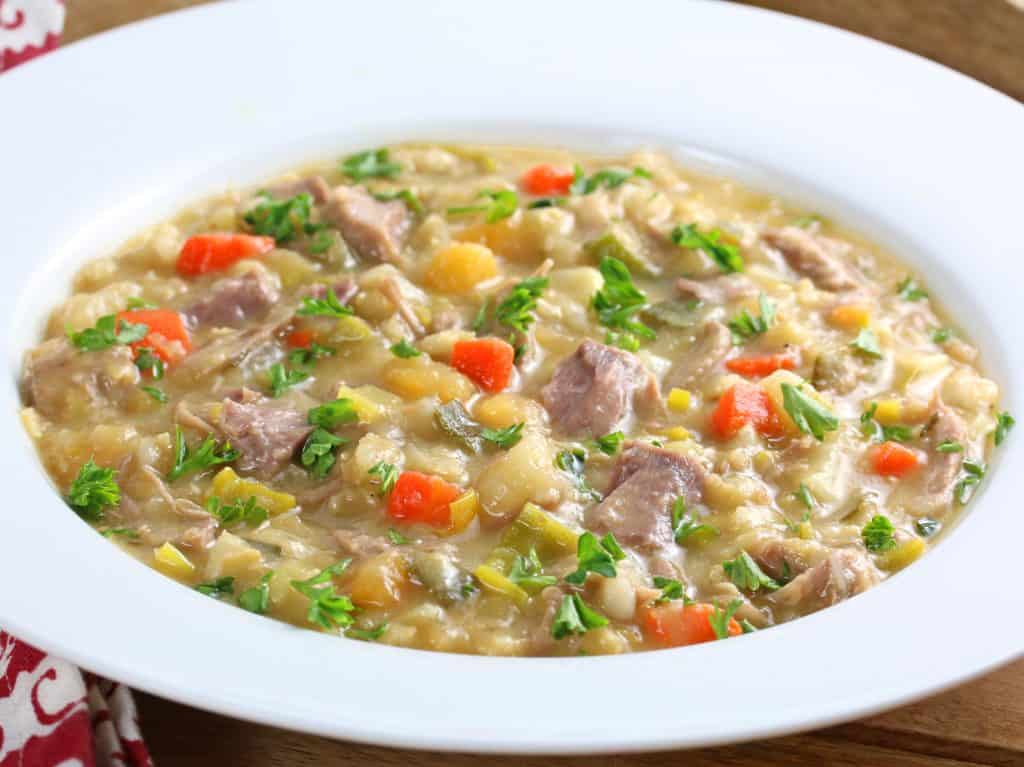
What is Scotch Broth?
Scotch broth is a traditional Scottish soup featuring lamb, barley, split peas, and vegetables. The first time I had this soup was in a small pub outside Inverness in the Scottish Highlands. It was the perfect meal for a cool afternoon and left me feeling happily nourished and rejuvenated, ready for more sightseeing adventures. Once we got home I got work replicating that wonderful dish and it has remained a family favorite ever since.
In her 1856 cookbook, Cook and Housewife’s Manual, Margaret Dods referred to Scotch Broth as the “Pot au Feu of Scotland.” Pot au Feu has also been referred to as “the quintessence of French family cuisine [and] the most celebrated dish in France” so in like manner is reflective of the important place that Scotch Broth has taken at the Scottish family table for centuries. Scotch Broth has been referenced in literature dating back to the 1600’s and it’s popularity has crossed many borders, including the U.S. where the recipe appeared in an 1881 American publication “The Household Cyclopedia.”
The popularity of Scotch Broth has become so widespread that it’s sold in cans in grocery stores and even some of the biggest brands have picked it up. I’ll admit I’ve never had the canned version but what I can tell you is that once you’ve made and tried the real deal you’ll understand why Scotch Broth has been so central to Scottish cuisine.
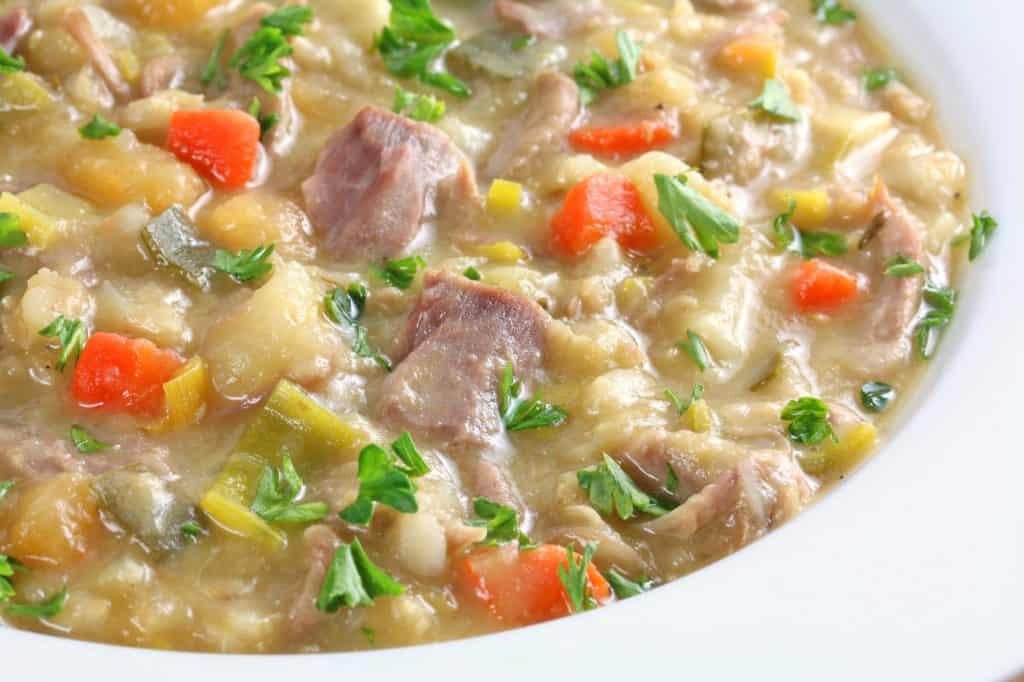
Scoth Broth Ingredients
The term “broth” is a little misleading because more so than a thin liquid that is sipped out of a mug or slurped from a spoon, it is a rich, hearty, thick and satisfying soup – really more of a stew – that has traditionally been eaten as the main meal. It’s loaded with vegetables, some fork-tender meat and generously thickened with barley, split peas and/or regular or red lentils.
Traditionally Scotch Broth would be made from whatever vegetables were in season but these would typically include rutabagas, carrots, turnips, cabbage, and leek. Mutton or lamb is very traditional and imparts an especially rich flavor, but beef may also be used. And if you have some bones to add to the pot, all the better.
Rich, robust and flavorful, Scotch Broth represents everything that is good about rustic home cooking. Traditional Scottish housewives, ever thrifty and knowing how to make much of little, knew how to gather up whatever fresh vegetables were available, add them together with lamb, mutton or beef, some barley, split peas and lentils (all staple Scottish ingredients), and simmer the mixture low and slow for hours to achieve a meal that by dinnertime would nourish both body and soul.
And so I present Scotch Broth, “the Pot au Feu of Scotland!”
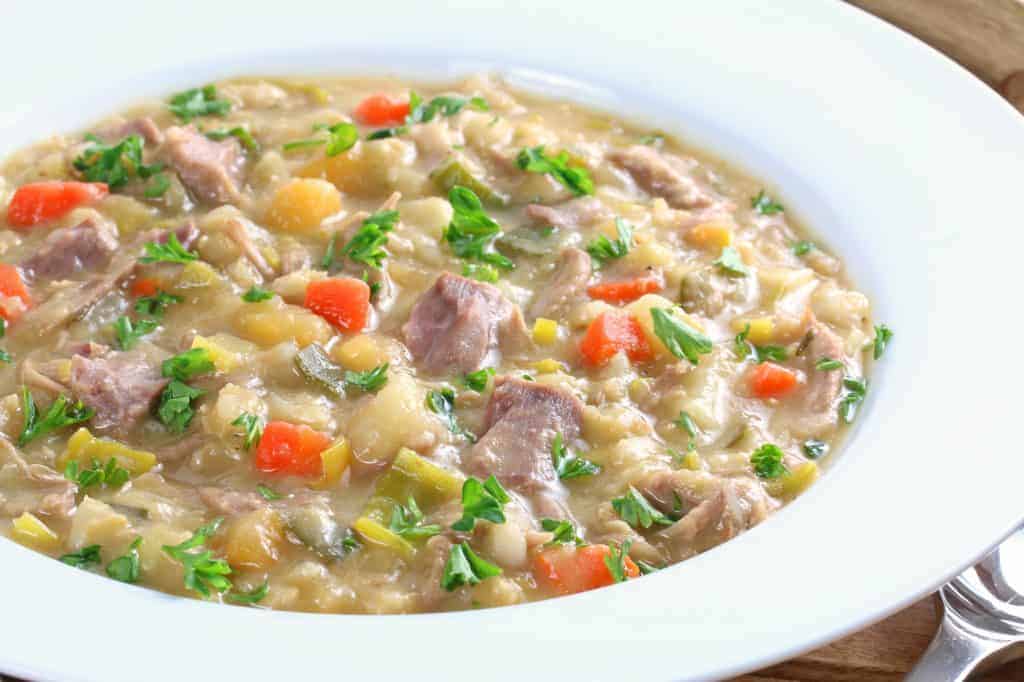
Scotch Broth Recipe
Let’s get started!
For a wonderfully flavor-packed Scotch Broth, we’re going to use leek, carrots, onions, rutabagas, turnips and parsnips. Get those cleaned and diced.
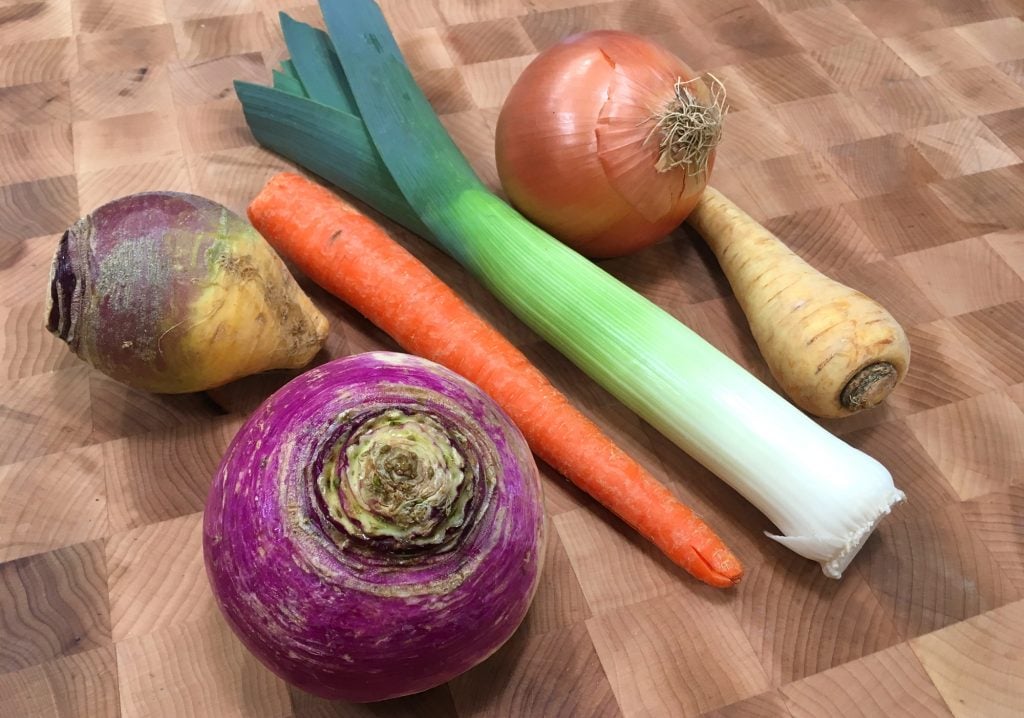
Cook the onions and garlic in the oil in a heavy stock pot or Dutch oven until softened 4-6 minutes.
Cook the onions and garlic in the lard or butter until softened, 4-6 minutes. Add the lamb, herbs, barley, split peas and salt. I tie my herbs with a bit of twine for easy removal later. That’s entirely optional.
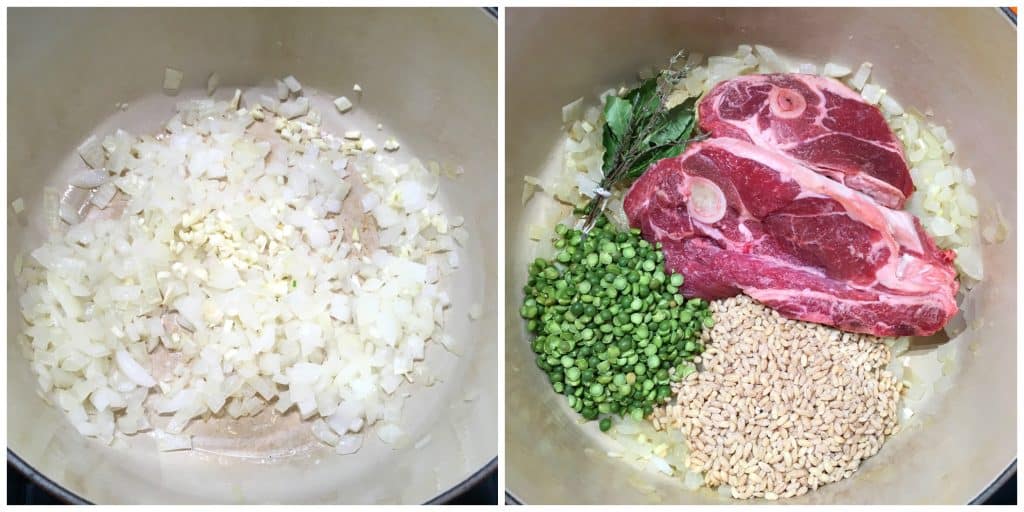
Add the broth, bring to a boil, reduce the heat to low, cover and simmer for 2 hours. Skim off any foam.
Add the carrot, turnip, rutabaga and parsnip. Simmer for another hour.
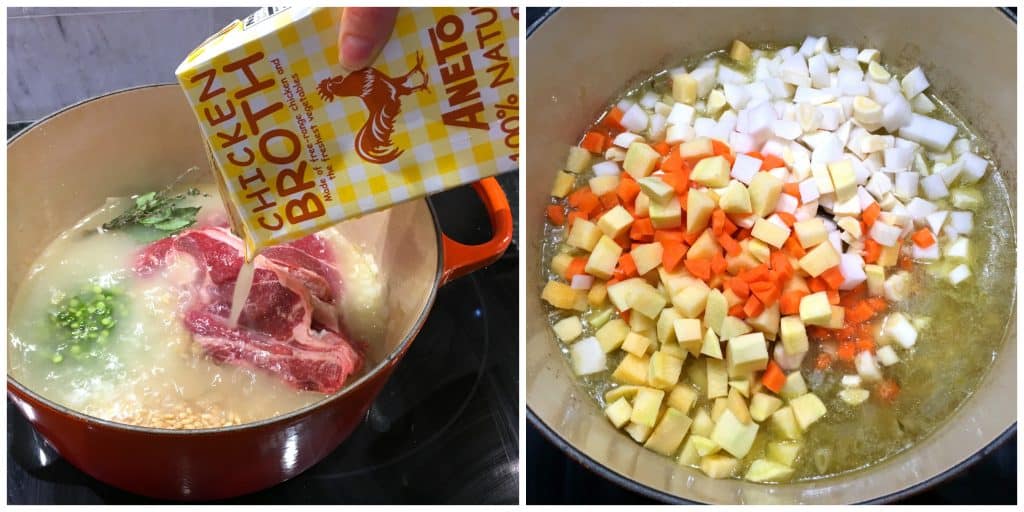
Remove the bay leaves and thyme sprigs. Remove the meat, shred it and discard the bones.
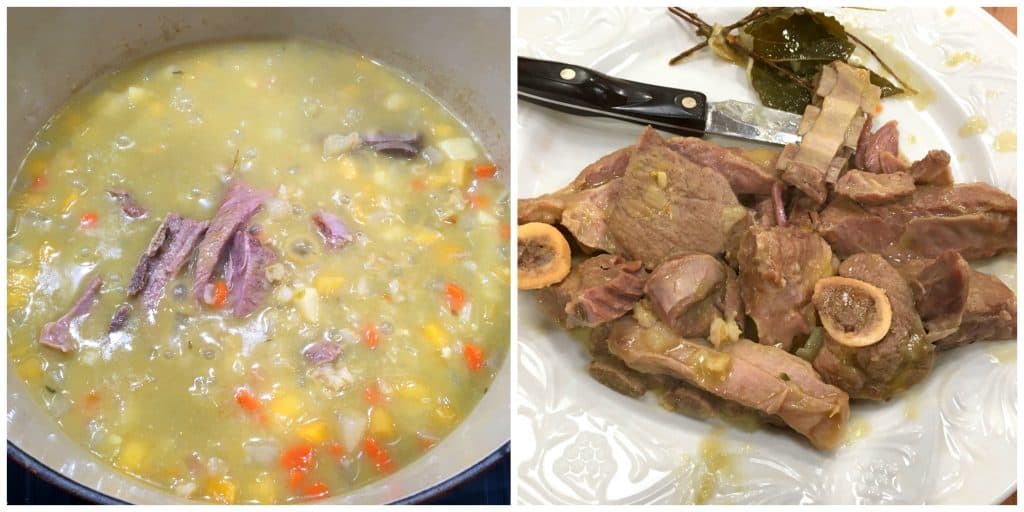
Return the shredded meat to the pot along with the leek and cabbage. Simmer for another 30 minutes. Add salt to taste.
We like this soup on the thick side, almost a stew. If you prefer the soup a bit thinner, add some more broth.

Serve garnished with fresh chopped parsley.
Enjoy!
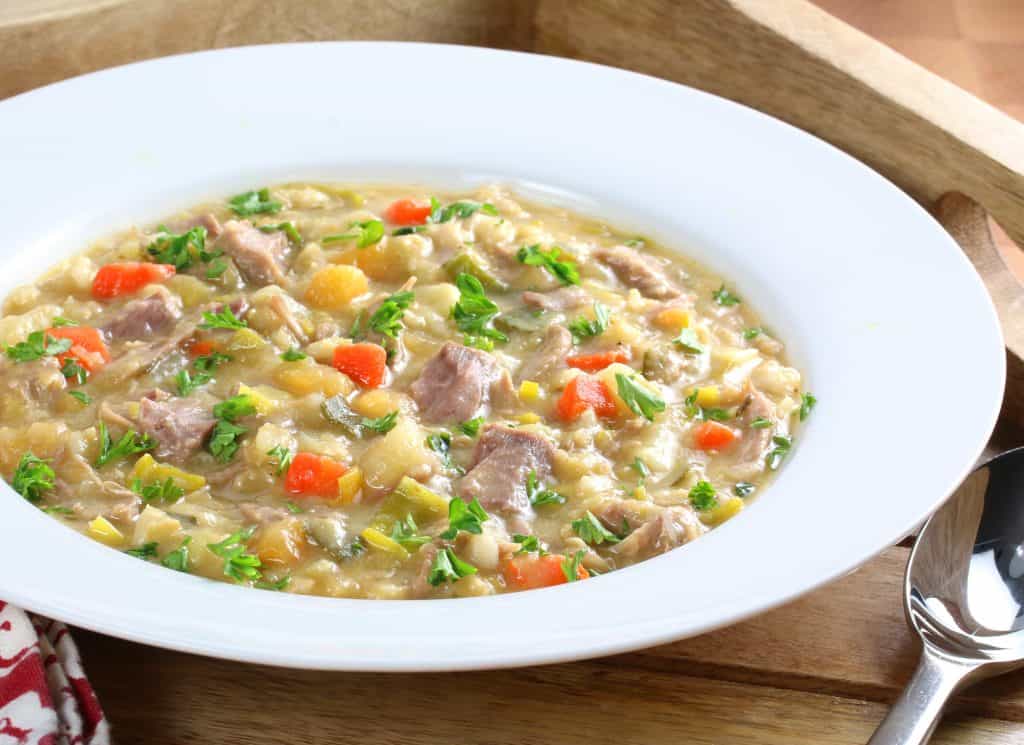
For more Scottish recipes be sure to try my:
- Dundee Cake
- Scottish Shortbread
- Millionaire Shortbread
- Scotch Eggs
- Cullen Skink
- Fish and Chips
- Bangers and Mash
- Scottish Barley Pudding
Save This Recipe

Traditional Scotch Broth
Ingredients
- 1 1/2 pounds lamb shoulder or shanks (or beef with bones)
- 2 tablespoons quality lard or butter
- how to make lard (it's super easy, click link for my tutorial!)
- 1 medium yellow onion, diced
- 3 cloves garlic, minced
- 1/2 cup pearl barley
- 1/3 cup dried green split peas
- 4 sprigs thyme
- 2 bay leaves
- 1 teaspoon salt
- 6 cups quality chicken broth
- homemade chicken broth (click link for recipe)
- 1 large carrot, diced
- 1 turnip, peeled and diced
- 1 rutabaga, peeled and diced
- 1 parsnip, peeled and diced
- 1/2 cup shredded green cabbage
- 1 medium leek, chopped, rinsed and drained
- fresh chopped parsley for garnish
Instructions
- Cook the onions and garlic in the lard or butter until softened, 4-6 minutes. Add the lamb, herbs, barley, split peas, salt and broth. Bring to a boil, reduce the heat to low, cover and simmer for 2 hours. Skim off any foam. Add the carrot, turnip, rutabaga and parsnip. Simmer for another hour.
- Remove the bay leaves and thyme sprigs. Remove the meat, shred it and discard the bones. Return the shredded meat to the pot along with the leek and cabbage. Simmer for another 30 minutes. Add salt to taste. I like this soup on the thick side, almost a stew. If you prefer the soup a bit thinner, add some more broth.Serve garnished with fresh chopped parsley.
Nutrition
Originally published on The Daring Gourmet March 18, 2018



















How many servings does x1 yield?
Hi JB, this recipe makes 6 servings.
wtf is rutagaba? never heard of it in all my 56 years in Scotland..
Hi Scott, they’re called Swedes in the UK.
turnip and rutabaga are the same thing. I don’t think we put cabbage in Scotch broth, must be a new recipe.
Turnips and rutabagas (also called swedes) are not the same thing. The addition of cabbage is definitely not a new thing, both cabbage and kale are very traditional additions. But as with any traditional recipes, every family has their own way of making them.
Why does someone think turnips and rutabaga are the same thing?!
Absolutely LOVE this recipe, it’s delicious and I love cooking something that my ancestors would have made
Thank you so much, Nikki, I’m thrilled that you enjoyed it! And I’m with you all the way on that sentiment – making dishes from our family heritage is a really special way to connect <3
I picked some lamb to make this. I’ve always loved lamb but don’t have it often. I made this as written down to the turnip (it was educational for me to learn the difference between a turnip and a rutabaga, haha) and I will tell you that this is undoubtedly one of the best stews our family has eaten. It has fully earned its place as a family favorite. I’ll be going back to the store to get some more lamb and vegetables to make another batch this weekend. It’s cold with more snow in the forecast and this stew is the perfect warming comfort food. Thank you!
Thank you so much for the positive feedback, Bebe, I’m beyond thrilled that your family loved this! <3
This has become one of my most favorite stews and is something I look forward to every winter. I’ve made this at least 20 times over the the past 4 years and I still savor every bite. It’s so flavorful and comforting, I can’t recommend this Scotch Broth enough.
That’s wonderful, Tina, I’m thrilled that this has become a regular and I really appreciate the feedback, thank you!
Can I add Orzo as can’t have pearl barley? Have a gluten free broth mix.
Hi Magi, yes you can. It only takes about 10 minutes to cook so add it in towards the end. Please note though that orzo is wheat so it isn’t gluten free.
Everyone in my house loves this recipe! We use the insta pot to cook it and the meat is very tender. The vegetables add a touch of authenticity and season it so well. Most loved recipe! Thank you 😊
That’s wonderful, Lauren, thank you so much, I appreciate it!
Sounds good. I love most soups. “Skim off foam” bothers me a bit, though. What would cause foam???
I would not eat either lamb or beef. Could I substitute chicken or sausage of some description?
Hi OAP, there’s no pretty way to say it, the foam is the coagulated proteins from the bones and meat. You can see it regularly when making meat/bone broths, whether beef, lamb, or chicken, etc. And it’s not just from meat proteins, the foam is also common in other high protein foods like lentils. Yes, you can substitute with chicken or another protein if you prefer.
Delicious! Thyme and Lamb broth is key. My husband and I loved it!!!
I’m so glad, Michelle, thank you very much!
This soup is legit, fantastic, flavorful and hearty! I saved the lamb bones from another meal and used them to amplify the lamb flavor.
That’s wonderful, Lori, I’m thrilled that you enjoyed it, thank you so much!
My son was wanting a Scotch Broth with pear barley so I found your site and made it exactly to your recipe and it was superb! It makes rather a lot and was so filling we have been eating it for the last 3 days .. I’m rather sorry we have run out but I have promised to make this again very soon. Autumn in the UK cries out for a dish like this with crusty bread and a log fire .. I look forward to following you and trying out some more of your recipes. Thank you.
Oh that’s wonderful, Anita, I’m so glad you guys enjoyed this, thank you! <3 I couldn't agree more, this really is such a perfect dish for the cool weather. Friendly greetings to the UK! We were there in June and then again last month. Already looking forward to a return trip in the spring :)